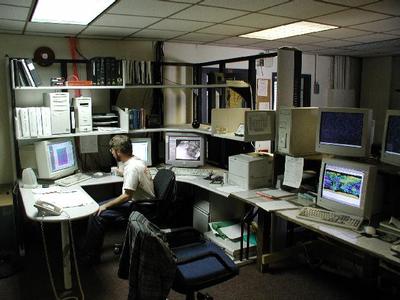25 November, 2001
Antarctic weather is legendary for its extremes. For incoming flights
carrying personnel and materials, the prediction of this weather is
critical. This afternoon (Sunday) was slow in our lab, so I took a walk to
the "nerve center" for meteorology in Antarctica, and spoke with Steve
Pooler and Art Cayette about just how this all goes down.
As you can imagine, much has changed in the last ten years. They laughed out
loud when I asked about how much of their predictions involved a "gut
feeling." It was an inside joke that was the product of years of having to
make predictions without the support of the data that would have helped. Why
no data? It has to do with the sun's position relative to the satellite.
Unfortunately, the "noise" produced by solar radiation coincides with the
position of the satellite to produce about seven hours of silence from the
technological heavens. Much of this has been resolved. Two major modern
sources of satellite information are NOAA (National Oceanic and Atmospheric
Administration) and DMSP (Defense Meteorological Satellite Program). An
additional and highly useful source of information is the Antarctic
Mesoscale Prediction System (AMPS-- which is visible to you online). This is
not a satellite source, but a computer model of the continent's weather
based on current meteorological data. Fially, SeaWiFS (Sea Viewing Wide
Field of View Sensor Program) is an expensive subscribed source of data that
helps to predict the weather.
I asked how their accuracy diminished over time, and was surprised to learn
that in spite of Antarctica's notorious reputation for having weather blow
up without warning, their two and three day forecasts were ironing out to
about 75% to 80%, and a surprising 75% for four days. Twenty four hours
yields a 90% correct prediction.
McMurdo is somewhat sheltered by the terrain that surrounds it. The
topography also batters outlying areas through a phenomnon known as the
Katabatic Wind. Cold, dense air high on mountains or plateaus (like the East
Antarctic Ice Sheet) is either "pulled" down by local lows that rise (a weak
Katabatic scenario) or pushed down by some intruding, overriding weather
system. This dense air that is already prone to descend does so with a
vengeance.
I should have talked to these folks sooner--it snowed two nights ago in a
way that is rare in Antarctica. The wind was light, and perfect little snow
crystals floated down. They knew it was coming! Hopefully, I will capture
these the next time they fall. The chemicals are ready and waiting outdoors
at the loading dock....
_________________________________________________________________
Get your FREE download of MSN Explorer at http://explorer.msn.com/intl.asp

Steve Pooler works at a bank of computers that help him to predict the weather at McMurdo Base in Antarctica. _________________________________________________________________ Get your FREE download of MSN Explorer at http://explorer.msn.com/intl.asp
Contact the TEA in the field at
.
If you cannot connect through your browser, copy the
TEA's e-mail address in the "To:" line of
your favorite e-mail package.
|
